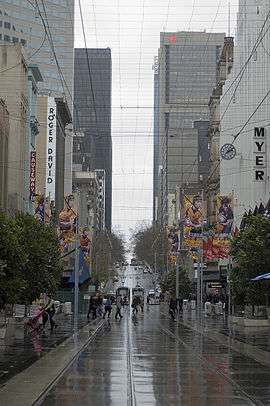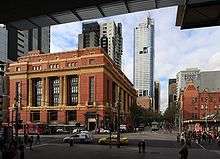Bourke Street, Melbourne
| Bourke Street Victoria | |
|---|---|
 | |
| Bourke Street Mall, between Swanston Street and Elizabeth Street looking west | |
 Bourke Street | |
| Coordinates | |
| General information | |
| Type | Street |
| Length | 2 km (1.2 mi) |
| Major junctions | |
| West end | Collins Street, Docklands |
|
Southern Cross railway station William Street Queen Street Elizabeth Street Swanston Street Russell Street Exhibition Street | |
| East end | Spring Street, East Melbourne |
| Location(s) | |
| Suburb(s) | Melbourne CBD |
| |
Bourke Street is one of the main streets of Melbourne's Central Business District (CBD) and a core feature of the Hoddle Grid. It was traditionally the entertainment hub of inner-city Melbourne, and is now also a popular tourist destination and tram thoroughfare.
During the Marvellous Melbourne era, Bourke Street was the location of many of the city's theatres and cinemas. Today it continues as a major retail shopping precinct with the Bourke Street Mall running between Elizabeth and Swanston Streets, numerous offices to the west end and restaurants to the east.[1] Bourke Street's liveliness and activity has often been contrasted with the sobering formality of nearby Collins Street.[1] For this reason, "Busier than Bourke Street" is a popular colloquialism denoting a crowded or busy environment.
Bourke Street is named for Sir Richard Bourke, the Governor of New South Wales in 1837 during the drafting of the Hoddle Grid.[2]
Geography
Bourke Street runs roughly from east to west and bisects the city centre along its long axis.[3] Bourke Street runs parallel between Little Collins street to the south and Little Bourke street to the north.
There are two primary stretches of Bourke Street, split by Southern Cross railway station: the historic city centre and the modern Docklands precinct. The city centre portion runs from Spring Street in the east (overlooked by Parliament House) to Spencer Street and Southern Cross Station. The newer Docklands end continues on the other side of the station (which is only accessible to pedestrians) and finishes at its intersection with Collins Street further west.
History

Having been laid out as part of the Hoddle grid in 1837, Bourke Street was considered "out of town" until the 1840s when the western end saw the opening of St Patrick's Hall, the first synagogue and the first public hospital. During the 1850s it gained a reputation as a busy thoroughfare popular as the centre for Saturday nightlife. As retail presence increased the street was often compared to London's Oxford Street.
Melbourne's first theatre opened on Bourke Street as the Pavilion (1841), and by the late 1840s the east end was established as Melbourne's main entertainment zone. Theatres and public halls were complemented by billiard halls, cigar divans, rifle galleries, bowling alleys and sideshows. While the early evening crowd trod Bourke Street's pavements for entertainment or for show, the night-time street was also notorious for public disorder, fights, brothel touts and drinking and drunkenness.[1]
Cheap restaurants appeared from the 1870s, when Parer's Hotel and Crystal Tea Rooms became a Melbourne institution, while the Café de Paris was a favourite literary and artistic meeting place. Twentieth-century restaurants such as Florentino's, Pellegrini's and the Society Café have become Melbourne institutions.[1]
The late 20th century onwards has resulted in office block developments, residential skyscrapers, the introduction of several shopping arcades and the famous Bourke Street Mall.
Bourke Street Mall
The Bourke Street Mall is a pedestrian and tram-only strip running between Swanston and Elizabeth Streets. The mall is Bourke Street's most famous feature and contains retail hubs like Melbourne's GPO, Myer's flagship store and David Jones' second flagship.
Concepts for a Bourke Street Mall were drawn up as early as 1964 by Robin Boyd and Frederick Romberg[4] however the ambitious multi-platform design which separated cars from pedestrians was never realised. Plans were eventually scaled down with pedestrians sharing space with a grade level tramline. The pedestrian mall was officially opened in 1983 by Their Royal Highnesses, Prince Charles and Diana, Princess of Wales.
The mall received a major facelift in preparation for the 2006 Commonwealth Games and elevated tram super-stops were later installed.
In the 2017 Melbourne car attack, a person on the run from police deliberately drove their car onto the footpath and ran over innocent bystanders at Bourke Street Mall. The attack claimed the lives of six people, including one baby and one child. Over twenty-five victims were hospitalised with injuries.[5]
Melbourne's Arcades
Many of Melbourne's famous arcades and shopping centres connect to Bourke Street, including:
- Melbourne's GPO, the former General Post Office that was converted into a shopping centre in 2004
- Royal Arcade, a heritage shopping arcade from 1869
- Strand Arcade
- Midcity Arcade
- The Walk Arcade
- Centrepoint Shopping Centre
Events

The inaugural Myer Christmas Window display was in 1956, the year of the 1956 Melbourne Summer Olympics and became an annual tradition. Myer's shopfront windows are decorated in a different Christmas-themed display and are visited by around 1,000,000 children and their parents each December.
The Myer Christmas Parade was an annual parade running down Bourke Street from Spring Street to the Myer windows. The parade was last held in 2010.

Docklands Commercial Zone
Bourke Street is a commercial zone lined by glass-paned skyscrapers, especially at its west end. Prominent skyscrapers include the National Australia Bank headquarters, 385 Bourke Street, Bourke Place, Marland House, National Bank House, AMP Square and AGL Energy (atop Southern Cross station).

Transportation
Tram routes 86 and 96 travel the length of Bourke Street and directly through the mall.
Parliament railway station is located at the eastern end of Bourke Street near the corner of Spring Street and is part of the underground city loop for the suburban rail network.
Southern Cross Station bisects Bourke Street at the city centre's west end and is a major transport hub for train and bus services throughout Victoria. The station also has shuttle buses to Melbourne and Avalon airports. A pedestrian bridge at Southern Cross Station provides access from Bourke St to Etihad Stadium and Melbourne Docklands.
Cinemas
Bourke Street has played a historically significant part in Melbourne's cinema industry. It was home to the city's first permanent cinema (although this was initially established near Princes Bridge), and by 1913 had developed into Melbourne's principal cinema precinct. In 1908, Arthur Russell began screening films at St. George's Hall, which was rebuilt as Hoyt's De Luxe Theatre in 1914, marking the beginning of the Hoyts cinema chain.
Bourke Street remained a centre for cinema-goers until quite recently. In 2005, the Hoyts cinema moved to larger premises at the Melbourne Central shopping centre. On 15 February 2006 the Village cinema closed down, leaving Village cinemas at nearby Crown Casino as the main Village branded city cinemas. The Chinatown Cinema, which inhabits the former Hoyts MidCity cinema, is the only cinema left in Bourke Street. On nearby Collins Street, the newly expanded Kino Dendy cinemas continues to be a cinema drawcard. The adjacent Russell Street Greater Union cinemas closed in 2013 and has since been demolished.
See also
![]() Australian Roads portal
Australian Roads portal
References
- 1 2 3 4 "Bourke Street". Retrieved 2016-11-17.
- ↑ "Melbourne's Streets & Lanes" (PDF). The Royal Historical Society of Victoria. Retrieved 28 April 2016.
- ↑ "Untitled", Bay Of Plenty Times, XIV (1804), p. 4, 21 February 1885
- ↑ Bourke Street development, Frederick Romberg and Robin Boyd, 1964, courtesy Robin Boyd Foundation and Diane Masters. State Library of Victoria collection.
- ↑ Butt, Craig (2017-01-20). "Live: CBD horror, three dead, 15 injured as car knocks down pedestrians". The Sydney Morning Herald. Retrieved 2017-01-20.
External links
| Wikimedia Commons has media related to Bourke Street, Melbourne. |
- Bourke Street Mall – Official government tourism site